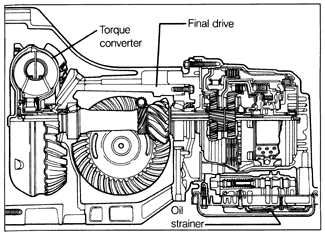Clutch or Torque ConverterThe clutch provides a way to connect or disconnect the engine and the rest of the drivetrain. A friction disc, attached to the input shaft of the transmission, gets squeezed between the heavily spring-loaded clutch and the flywheel, both positively attached to the engine. Normally, the friction between the clutch, friction disc, and flywheel, aided by the heavy spring, makes the transmission input shaft turn at the same speed as the engine. For stopping, starting, and shifting gears, depressing the clutch pedal works against the clutch spring, reducing the friction bond and disconnecting the engine from the drivetrain. In normal use the clutch and flywheel wear, much like brakes, and need periodic maintenance or replacement. More information on the clutch is found in MANUAL TRANSMISSION AND CLUTCH. Cars with automatic transmission achieve the same result with a sophisticated fluid clutch called a torque converter. With one part attached to the engine and another to the transmission, power is transmitted between the two by the action of a viscous fluid. The design of the torque converter is such that it allows the engine to turn at idle speeds without transmitting much driving force to the transmission. A slight forward tug may be noticed when the car is in a forward gear, but at idle speed it is barely enough to drive the car. Above idle speeds, the torque converter becomes increasingly resistant to slip, and transmits power through the fluid coupling to the transmission, delivering power to the wheels. Fig. 1-9 is a cutaway view of the automatic transaxle showing the torque converter. For more information, see AUTOMATIC TRANSMISSION.

|